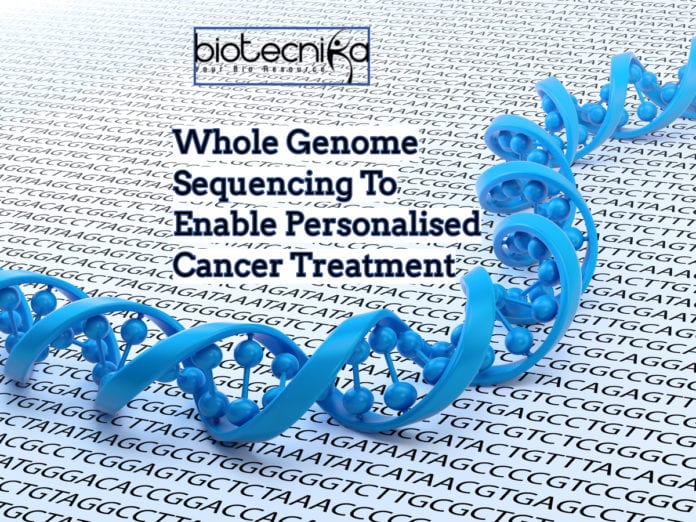Whole Genome Sequencing for Cancer Treatments
Our human genome comprises a string of molecules called nucleotides. Nucleotides are represented by the letters A, C, G& T. But sometimes, changes occur in the ‘spelling’ of our DNA i.e, an A becomes a G for example. These nucleotide changes are known as mutations that can be caused by a number of factors, or by even some spontaneous, others environmental, such as exposure to tobacco smoke or to ultraviolet light & all leave characteristic signatures on our genome.
As the cells divide and multiply, they make copies of their DNA; So if there are any spelling mistakes, that will be reproduced. Over time, the number of errors gets accumulated, leading to an uncontrolled cell growth i.e, the development of tumors.
Whole-genome sequencing is a technique that involves reading the entire genetic blueprint of a cancer cell and also compares it to a patient’s healthy cells to see how their DNA has mutated. By studying the mutations present in a whole cancer genome and also seeking all the signatures in them, it is actually possible to identify the various factors that have acted upon the tumor cell.
In order to understand whether Whole-genome sequencing
might be useful in a clinical setting, Cambridge scientists teamed up with their colleagues in Sweden running a population-wide project called SCAN-B, that has been recruiting all women with breast cancer in the South of Sweden since the year 2010. And this was critical as SCAN-B has a large amount of clinical outcome data.This international collaboration of scientists used Whole-genome sequencing to analyze tumors from individuals who had been diagnosed as having triple-negative breast cancers. And these cancers are so-called because these lack 3 key molecules known as receptors. They account for around nine percent of breast cancers and are associated with poorer outcomes. These cancers are also more common amongst women with African and Asian ancestry.
Whole-genome sequencing gave the team a complete view of the cancer genome. It reveals many things that the team couldn’t see previously because we simply did not look for them, explained Dr. Serena Nik-Zainal from the Medical Research Council Cancer Unit at the University of Cambridge, who led this study.
And having a complete cancer genome map for each patient helps us to understand what has caused each patient’s tumor and treat each them more effectively. Formerly, it was like going on a voyage with only a limited map, but now, with whole-genome sequencing, researchers have a much better, more detailed map and know the best route to reach our destination, he added.
The scientists then applied a machine learning algorithm called HRDetect, which they had previously developed to identify tumors with signatures caused by mutations in the genes BRCA1 or BRCA2. Having a variant of either of these 2 genes greatly increases an individual’s risk of developing breast cancer and a relatively new class of anticancer drug called PARP-inhibitors have been developed specifically for these tumors. HRDetect scores had suggested that a greater proportion of women in the general population could have tumors that are very similar to BRCA1/BRCA2-mutant cancers.
Taking the scores, the team categorized each patient as either high, intermediate or the low scoring.
Individuals who scored highly were those that had the best outcomes using current treatments for triple-negative breast cancers are also most likely to respond to the PARP inhibitors.
And surprisingly, those with intermediate scores had the poorest outcomes. Current triple-negative breast cancer treatment had limited effectiveness suggesting that novel approaches would be necessary to tackle these cancers. The genetic changes and its signatures revealed through Whole-genome sequencing gave clues to the mechanisms driving these tumors, that in turn may help to inform the development of new drugs.
Patients with low scores have poor outcomes, though not as bad as those in the intermediate group. However, the Whole-genome sequencing profile in some of these tumors suggested biological abnormalities which could potentially be targeted by existing drugs or the drugs currently going through its clinical trials, such as so-called checkpoint inhibitors or the AKT inhibitors.
Using the whole-genome sequencing technique, researchers can truly discriminate tumors that may or may not respond to current medicines among triple-negative breast cancer patients, a type of breast cancer that we still struggle to treat well, said first author Dr. Johan Staaf at the Lund University in Sweden.
Importantly, this approach also gives clues to some of the mechanisms which are going wrong in the poor-outcome tumors, and hence how we might treat those tumors differently or how we might develop new drugs.
Speed of DNA sequencing technology has progressed such that Whole-genome sequencing can be carried out within 24 hours, with another 24 to 48 hours for analysis of the data. In theory, it should be possible to offer WGS as a matter of course to all patients, allowing a personal readout of their tumor and potential treatment options.
The potential for whole-genome sequencing technique is to open up a personalized approach to treating cancer is huge, said Dr. Nik-Zainal. he added that in the past, the cost and issues with managing the huge volume of data created barriers to its widespread application. But researchers are moving closer to a time where this can be routinely offered to all tumor patients, with the potential to transform the management of even difficult to treat cancers.






























